

B2 First (FCE) Essay Writing Guide
The Cambridge B2 First (FCE) essay is easier to write than you think! Follow these steps to write the perfect essay.
Post Contents
What is the Cambridge B2 First Essay?
- Part 1 of the writing test – there are 2 parts total
- 140-190 word limit
- You have about 40 minutes to plan and write your essay
- You must answer a question using two notes and your own idea
- The topic requires general knowledge only
- The essay is always formal because it is written “for your teacher”
Step One: Look at the Task (1 minute)
To begin, all B2 First essays have a similar format . This is great because you know exactly how to write the essay before seeing the question.
Read the essay question carefully and HIGHLIGHT any keywords you need to write about.
Tip: If you don’t understand the question or notes, DON’T PANIC. Try your best to write the essay. You will still get points for grammar, vocabulary, and structure.

Sample exam test from Cambridge English .
Step Two: Write a plan (5 minutes)
A lot of my students dislike writing a plan. However, a plan helps you organize your thoughts and helps you write a better B2 First essay. Your essay needs 5 paragraphs . We will use the sample task from above as an example:
Paragraph structure for an essay
Introduction.
- Rivers and seas
- Your own idea
Next, to create a plan, write a few words for each paragraph . DO NOT write whole sentences. This takes too much time. Try to focus on keywords and short phrases .
Tip: “Your own idea” DOES NOT mean your opinion. You need to think of another topic related to the question to talk about. Some ideas for this task could be: recycling, agriculture, industry, etc.
Additionally, you can prepare a list of linking words and related vocabulary . Getting these words written down before you start helps you remember to use them.
Look at the example plan below. You can draw something similar on a blank piece of paper.
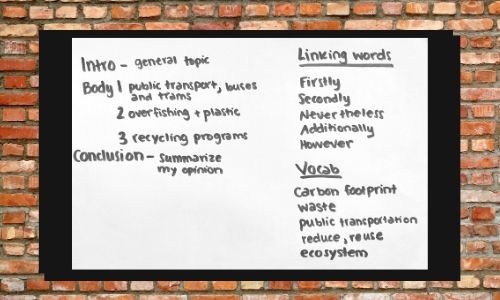
Tip: Time yourself – see how long it takes for you to write a plan. Try to reduce that amount of time as much as possible.
Step 3: Write your essay (32 minutes)
On the official test, you must write with a pen . No erasable pens or pencils are allowed. I suggest writing your plan and essay with a pen every time you practice .
Let’s take a look at each paragraph of the essay.
The introduction to your essay should be 2-3 sentences long . It introduces the essay topic in a general way .
Tip: DO NOT include your opinion in the introduction. Your opinion goes in the conclusion.
If you are unsure how to write an introduction, try this structure and look at the example :
Structure of the introduction
- 1 sentence about the topic in general
- 1-2 sentences about the topic more specifically, including a question if you like.
Example Introduction
On every continent, the amount of trash and waste is increasing each year. Rubbish causes damage to ecosystems all over the world. Is there a way for countries to reduce their carbon footprint and save our planet?
Body of the essay
The body of the essay has three paragraphs . These paragraphs talk about one idea with supporting examples .
For each paragraph, you need to write a topic sentence. A topic sentence is the main idea of the paragraph . DO NOT copy the notes. Instead, try to rewrite the idea in your own words. This is called “paraphrasing.”
Your paragraphs should be 3-4 sentences .
Tip: Start each paragraph with a linking word .
Structure of a body paragraph
- Linking word and topic sentence
- Supporting sentences
Example body paragraph
Firstly, countries can decrease pollution and environmental stress by offering more public transportation. Cars and other vehicles which require petrol produce toxic fumes. If more electric buses and trams were available, fewer people would need to drive their cars.
Follow the same structure for each body paragraph.
Tip: Remember that “your own idea” is NOT your opinion . Write about an additional topic related to the question that you wrote down on your plan.
Finally, you get to say your opinion! In the conclusion, you need to summarize the topic and give your opinion on the question. A conclusion should be 1-2 sentences long.
Structure of the conclusion
- Transition word and a sentence summarizing the topic
- A sentence that gives your opinion
Example conclusion
To sum up, countries around the world must make changes in order to protect the environment. In my opinion, offering more public transport, reducing overfishing, and creating recycling programs are necessary for a cleaner planet.
Step Four: Review your writing (2 minutes)
This is another important step that students often miss. Take two minutes after writing your essay to check for spelling and grammatical errors.
Since you wrote in pen, simply cross out the incorrect word or words LIKE THIS and rewrite them.
How can I get a higher mark on the FCE essay?
Now that you know how to write an essay for the Cambridge B2 First exam, let’s look at how to get the best mark possible .
Increase your mark on your B2 First essay
- Include 5-8 linking words – these words introduce paragraphs and connect ideas
- Use a variety of grammatical structures – you should have both simple and complex forms. Try to use perfect and future forms, conditionals, comparatives, relative clauses and passive
- Use formal vocabulary – do not use slang or simple words like “good, big, small, bad.” Also, do not use contractions. Write “cannot” instead of “can’t”
- Make the essay interesting to read – the examiners read hundreds of essays so make yours easy to read and engaging
- Use the correct amount of words (140-190) – it’s ok to be a few words over the limit, but not too many
Final Advice
The best way to improve your writing skills … is to write! Try to write a few essays each week and ask your teacher for feedback . I have had students who entered my class with very poor writing skills and with practice, they were able to pass the exam after only 10 weeks!
I help students prepare for the FCE exam with private lessons via Zoom. Email me at [email protected] or check out my private lessons page to learn more.
If you want more practice for the B2 First , try these Speaking exam tips , free writing checklist , and Reading part 1 practice.
ESL Teacher 365 Online Courses & Memberships
Teach online in 10 days mini-course.
A step-by-step 10 lesson mini-course that will teach you how to become an online teacher so that you can life a life of freedom & flexibility - with unlimited income potential!
TEFL Teacher Roadmap Teach Course
A proven step-by-step formula that will teach you how to move abroad with confidence & clarity. A self-study online course for anyone asking "NOW WHAT?!" after completiting their TEFL certificate.
Teach Abroad Club Membership
Ready to start your teach abroad adventure? Teach Abroad Club is the ONLY monthly membership & community that supports you through the teach abroad process - every step of the way.
Follow ESL Teacher 365
More posts from the blog.

Teach Abroad Documents: Apostille Process for Americans
Jun 3, 2024
Learn about the process for legalizing documents for Americans who want to teach abroad.

8 Things You Should Look for in an International Teaching Contract
Jan 23, 2024
What should you look for when it comes to international teaching contracts? Find out in this guest post by Christopher Jacklin.

Effective Feedback in the ESL Classroom: Key Strategies for Success
Oct 12, 2023
Strategies for Feedback in the ESL Classroom – a guest post by RVF International.

Thanks for visiting ESL Teacher 365!
Certified Teacher & Founder of ESL Teacher 365
I am passionate about helping people teach abroad & online so they can live a life of adventure !
I’ve taught in 6 different countries and love sharing my teach abroad (and online) tips and tricks.
The world is yours to teach and explore!
– Jamie
Disclaimer: ESL Teacher 365 participates in Amazon Associates and other afilliate programs. This means I may earn a small commission if you use one of my links, at no extra cost to you. This helps me continue to provide helpful resources for teachers. Thank you!
- Advanced Search
- All new items
- Journal articles
- Manuscripts
- All Categories
- Metaphysics and Epistemology
- Epistemology
- Metaphilosophy
- Metaphysics
- Philosophy of Action
- Philosophy of Language
- Philosophy of Mind
- Philosophy of Religion
- Value Theory
- Applied Ethics
- Meta-Ethics
- Normative Ethics
- Philosophy of Gender, Race, and Sexuality
- Philosophy of Law
- Social and Political Philosophy
- Value Theory, Miscellaneous
- Science, Logic, and Mathematics
- Logic and Philosophy of Logic
- Philosophy of Biology
- Philosophy of Cognitive Science
- Philosophy of Computing and Information
- Philosophy of Mathematics
- Philosophy of Physical Science
- Philosophy of Social Science
- Philosophy of Probability
- General Philosophy of Science
- Philosophy of Science, Misc
- History of Western Philosophy
- Ancient Greek and Roman Philosophy
- Medieval and Renaissance Philosophy
- 17th/18th Century Philosophy
- 19th Century Philosophy
- 20th Century Philosophy
- History of Western Philosophy, Misc
- Philosophical Traditions
- African/Africana Philosophy
- Asian Philosophy
- Continental Philosophy
- European Philosophy
- Philosophy of the Americas
- Philosophical Traditions, Miscellaneous
- Philosophy, Misc
- Philosophy, Introductions and Anthologies
- Philosophy, General Works
- Teaching Philosophy
- Philosophy, Miscellaneous
- Other Academic Areas
- Natural Sciences
- Social Sciences
- Cognitive Sciences
- Formal Sciences
- Arts and Humanities
- Professional Areas
- Other Academic Areas, Misc
- Submit a book or article
- Upload a bibliography
- Personal page tracking
- Archives we track
- Information for publishers
- Introduction
- Submitting to PhilPapers
- Frequently Asked Questions
- Subscriptions
- Editor's Guide
- The Categorization Project
- For Publishers
- For Archive Admins
- PhilPapers Surveys
- Bargain Finder
- About PhilPapers
- Create an account
Essays to a Young Teacher
Reprint years, philarchive, external links.
- From the Publisher via CrossRef (no proxy)
- jstor.org (no proxy)
- jstor.org [2] (no proxy)
Through your library
- Sign in / register and customize your OpenURL resolver
- Configure custom resolver
Similar books and articles
Citations of this work.
No citations found.
References found in this work
No references found.

Are Native Speakers Better Language Teachers?
Reading skills – 7 great tips to improve, how to stay calm on your cambridge exam day, cambridge c2 proficiency (cpe): how your writing is marked, cambridge c2 proficiency (cpe): how to calculate your score, cambridge c2 proficiency (cpe): how to write a letter, cambridge c2 proficiency (cpe): how to write a report, cambridge c2 proficiciency (cpe): how to write a review, cambridge c2 proficiency (cpe): how to write an article, cambridge c2 proficiency (cpe): how to write an essay.
- Grades 6-12
- School Leaders
FREE Ice Cream Coloring Pages! 🍦
35 Unique Ways To Introduce Yourself to Students This Year
It’s all about that first impression!
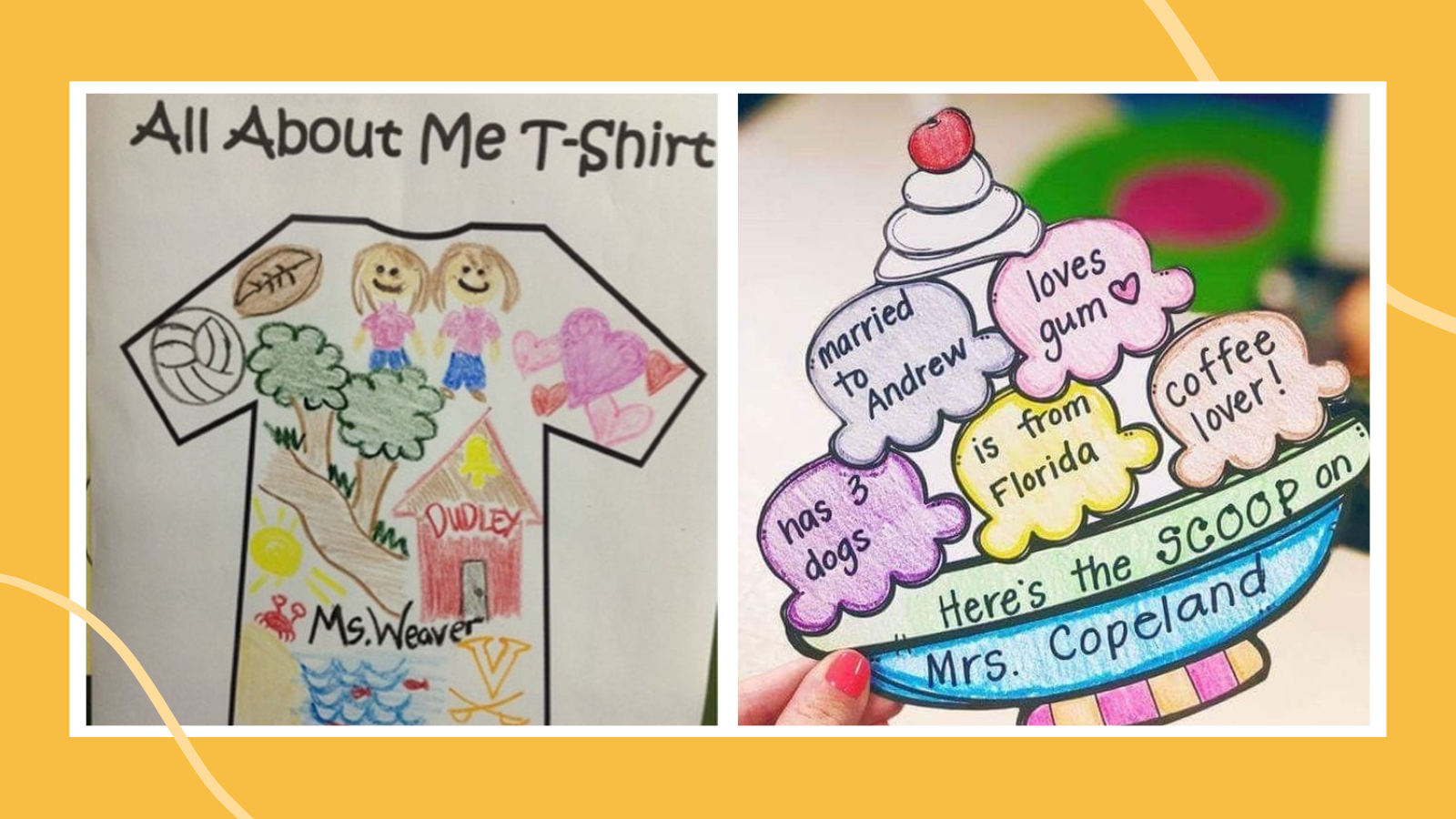
If you’re looking for a new and creative way to introduce yourself to students this year, we’ve got you covered! We gathered lots of terrific ideas, including some from teachers on the WeAreTeachers HELPLINE group on Facebook . They range from quick and easy options to some that will take some planning, but they’re all great ways to start the new year off on the right note.
1. Do a Teacher Feature on school social media
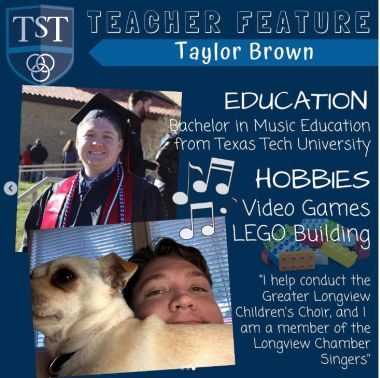
Lots of schools use their social media accounts to introduce teachers, like this example from @tstlongview . Propose the idea at your school, suggesting they do a teacher a day in the weeks leading up to back-to-school time.
2. Have last year’s students introduce you
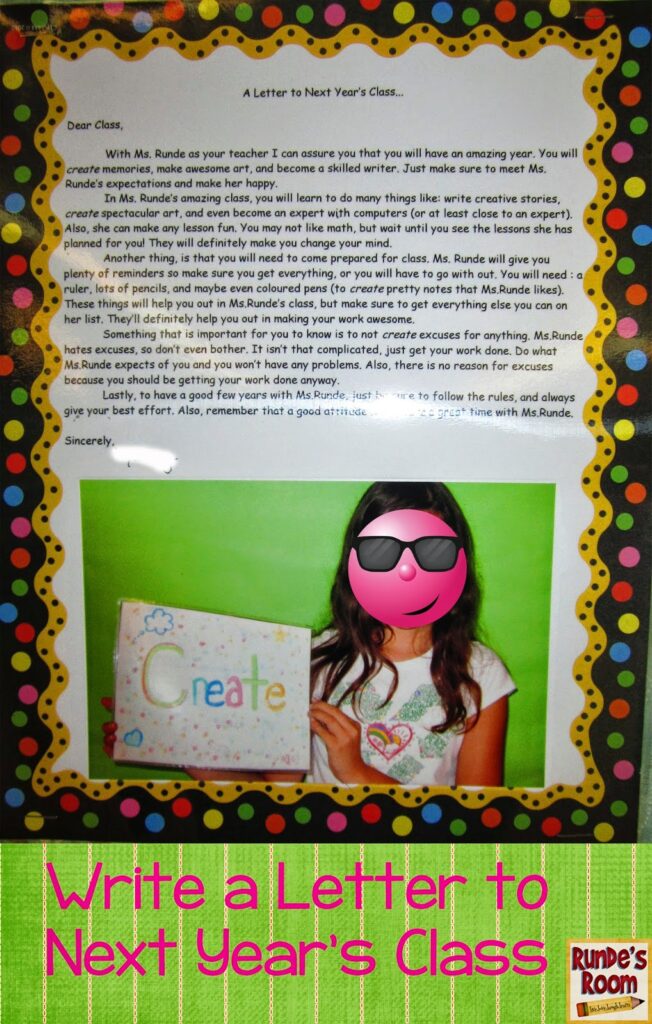
This fun learning activity not only allows your current students to introduce you to next year’s class, it gives you a chance to get feedback about how this year has gone! See how this teacher runs the lesson with her students .
3. Send postcards to introduce yourself
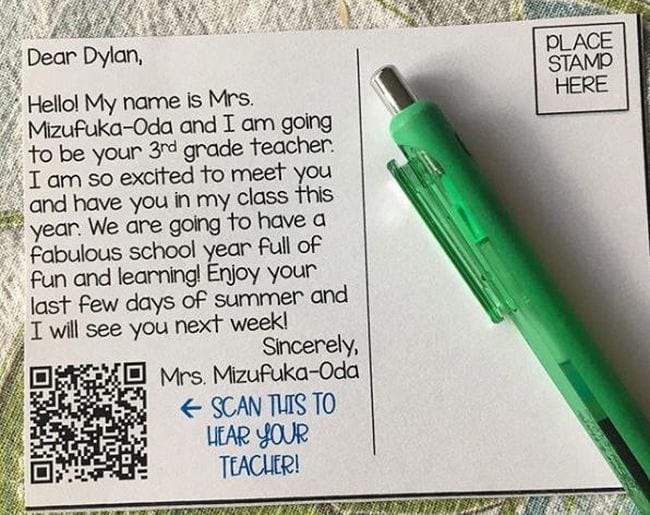
No time for a full letter? Try postcards instead. “I took a picture of me playing fetch with my trusty golden retriever and sent it to each of my new students over the summer,” James C. shares. “On the back, I wrote a short note introducing myself and telling them how excited I was to have them in my class.” See how The Techie Teacher uses this idea here.
4. Show them a slideshow
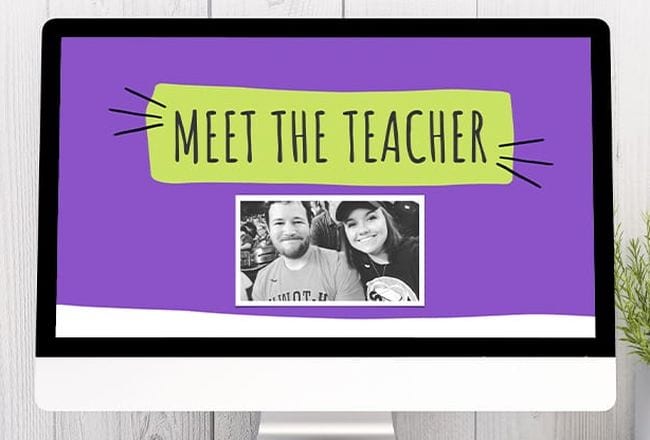
Lots of teachers use a slideshow to introduce themselves. We’ve made it even easier to create one with our free editable template—grab it here !
5. Introduce yourself with a quiz

First-day quizzes are a really popular way to introduce yourself to students. Kahoot even has an easy-to-customize template just for getting to know your teacher! Lisa T. does a slideshow about herself on the first day and then follows up on the second day with a quiz to see how much they remember.
6. Share your talents

Students expect the usual bio intro—I’m Ms. Smith, I’ve been teaching for 10 year, etc. But why not open with a bit of pizzazz by sharing one of your unique talents with students? Play a song on your trumpet, pass out cookies you made, display a quilt you made. Opening up with something personal will encourage your students to do the same.
7. Plan a meet-the-teacher escape room
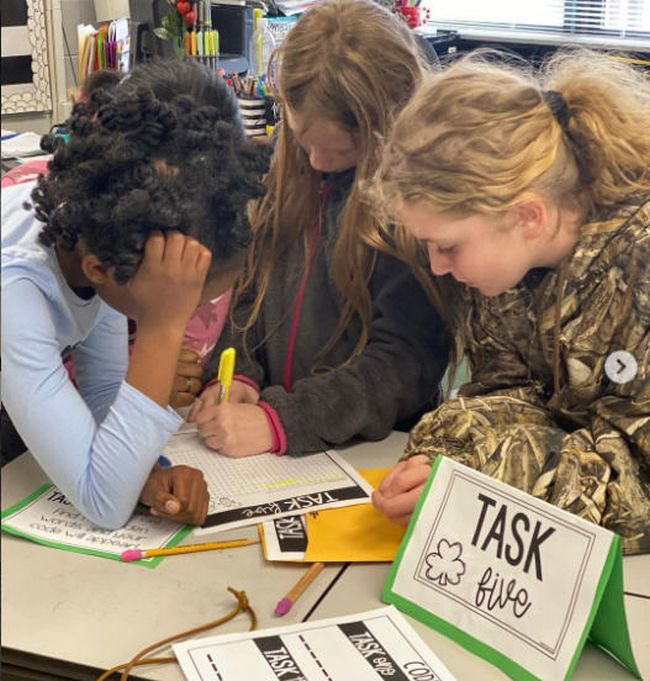
Source: @thekellyteachingfiles
OK, we admit this is going to take some work. But it’s a surefire way to amp up student excitement from day one! Set up an escape room to help kids learn more about you and explore the classroom at the same time. See how Mskcpotter does it here.

8. Play 20 Questions

After a brief introduction, open the floor to students’ questions about yourself and the coming year. This is a great way to reveal students’ wishes and hopes for the year as well as any concerns that are lurking beneath the surface. Be sure to have a “pass” option if students ask any questions that are too personal for you so you can deflect with good humor.
9. Use a student-created brochure
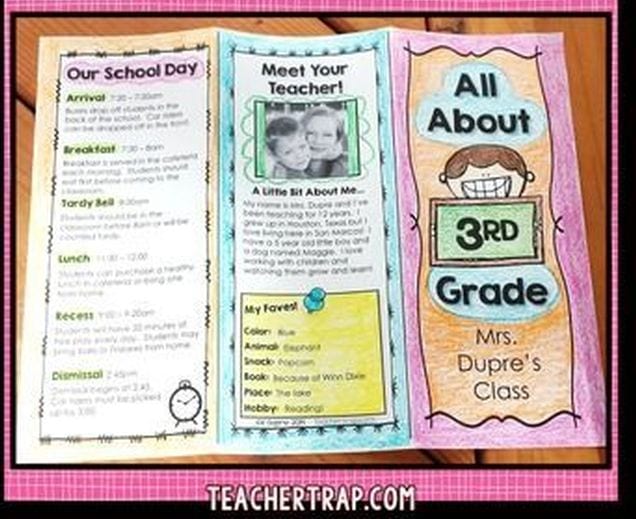
Emily F. lets her previous year’s class help her introduce herself to incoming students. Then she gives a quiz to see if kids really took the time to read it! “At the end of the year, I have my students make a brochure for next year’s students. If the kids read it, they get a lot of answers to my quiz questions right.” Looking for a template? We like this one from Teacher Trap .
10. Decorate a Bitmoji virtual classroom
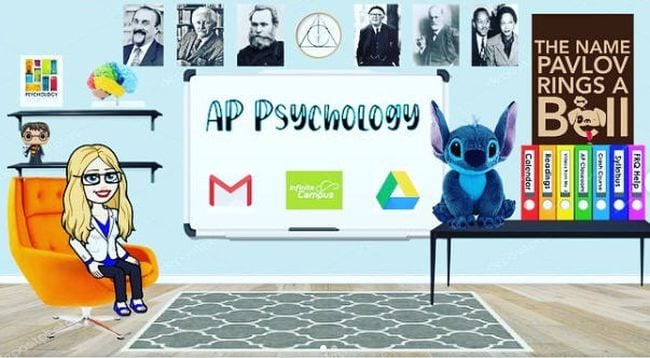
Whether you’re teaching in person or online, Bitmoji classrooms are a fantastic way to show off your personality. This one from The Social Studies World of Ms. J has clickable images to take students to different important links. Learn how to create your own here.
11. Read, run, and write

Get your students working collaboratively and focusing on their writing skills right away with this activity from the Busy Teacher . Write a list of facts about yourself—your background, family, hobbies, etc.—and post several copies of the list in the front of the room.
Divide your class into small teams and give each team a sheet of paper. One student in each group will stay at their desk while the others take turns running up to the board, reading and memorizing as much as they can before running back to the student at the desk who will listen and write down what they’re told. The first group to correctly write down the full list wins.
12. Build a word cloud
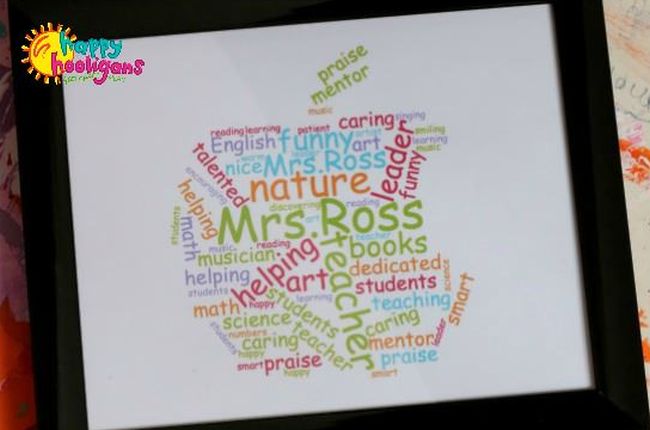
Word clouds are fun to make, and you can use this as an activity for all your students on the first day if you like. Make your own using instructions from Happy Hooligans using words that describe your background, hobbies, style, and more. Plus, check out these free word cloud generators for teachers .
13. Set up a question-and-answer match

Image source: JobCase
Fourth grade teacher Lori Silviera shares this fun activity: “I make Q and A’s on index cards about me,” she says, “and then the students try to find a classmate who has the answer or question that matches the card they get. After they partner, the person with the question reads it and then the partner that has the answer reads it to the rest of the class. For example: How many pets do I have? (One cat named Lenny).”
14. Pop an emoji bubble
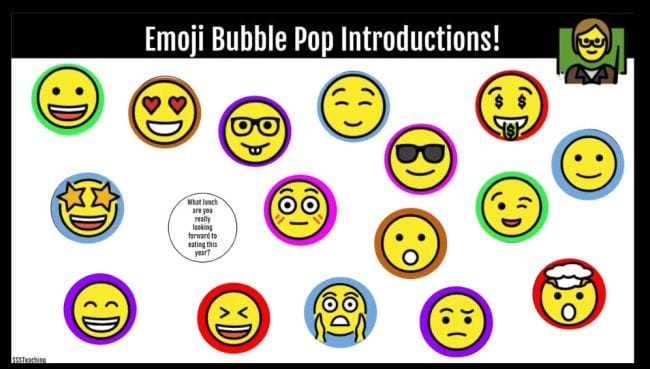
We love this clever little game that works with Google Slides and is perfect for virtual or traditional classrooms. Students pick an emoji and “pop” the bubble, and you answer the question to tell them a bit about yourself. Kids can play too! Get the game from SSSTeaching on Teachers Pay Teachers .
15. Create a Fakebook profile
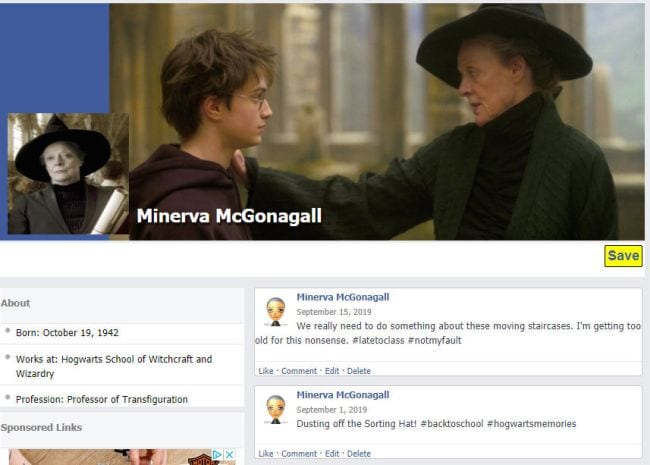
It’s not a great idea to show students your real social media pages. Instead, create a “Fakebook” profile, like teacher Marissa Q. does. Use the free online tool , or mock up one on paper, sharing interesting facts, photos, and other info about you that you’re comfortable with kids knowing.
16. Model a survey
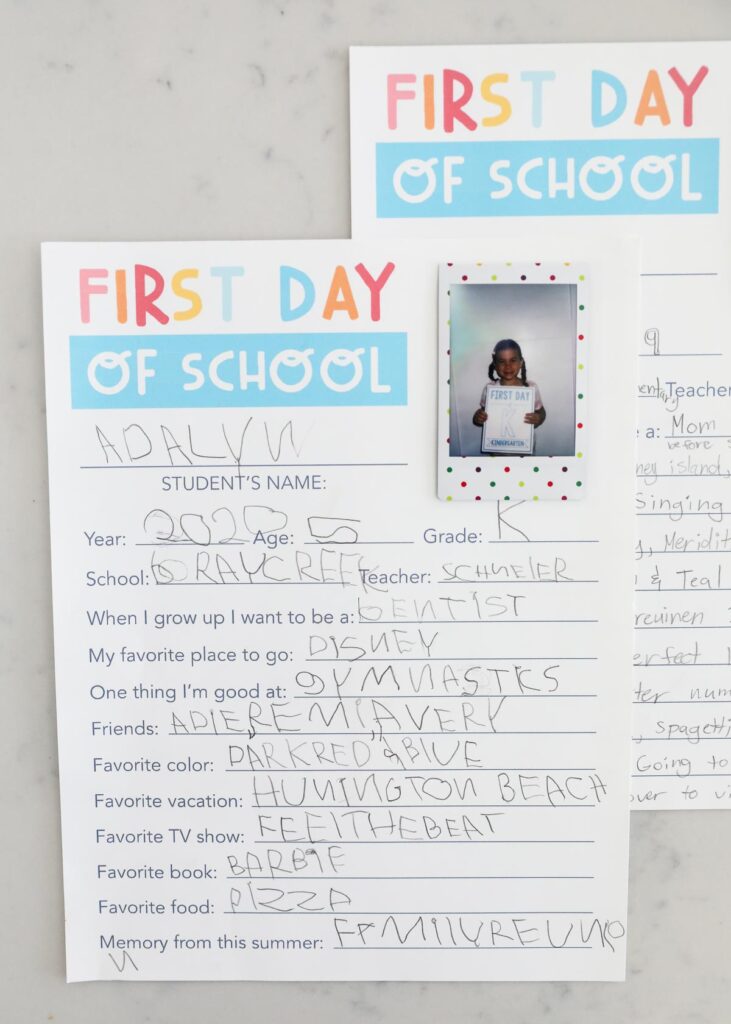
Try this fun and educational activity from the Art of Education. Student questionnaires/surveys are a great way to get to know your students, and for students to have an opportunity to share things with you at the start of the school year. Ask things like, “Do you have a nickname or middle name that you go by instead of what is on the roster?” “What is your preferred pronoun?” “How do you like to receive feedback?” etc. We like this list of questions from the Inspiration Board.
17. Let students research your life

Introduce yourself to your students with a lesson on gathering info from trustworthy primary sources . “I give students a stack of primary documents from my life (letters, report cards, class pictures, etc.) with all the sensitive information blacked out,” eighth grade teacher Phil L. says. “I ask the students to create a timeline from that information, hypothesize about what happened in the gaps, and draw conclusions about the kind of person they think I am.”
18. Try a game of This and That
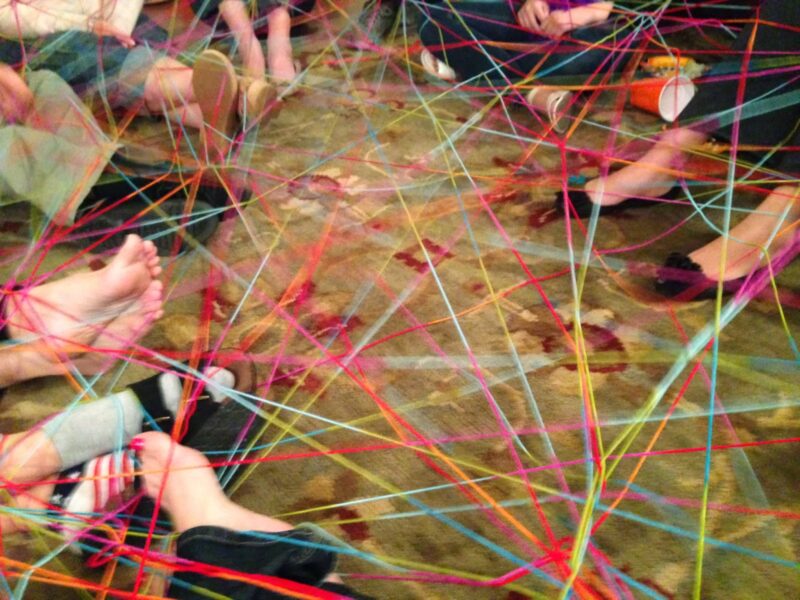
Your new students will love this hands-on “get to know you” game from Amateur Craft Hour . The game begins with the first person securing a ball of yarn to their wrist. Then, they choose a stick with a word written on each side—for example, fame and money. They choose which one they would prefer. Then, they ask those who would make the same choice to raise their hand and toss the yarn to one of them. Play continues until the yarn has woven quite a web illustrating that we are all connected in some way.
19. Hold a scavenger hunt
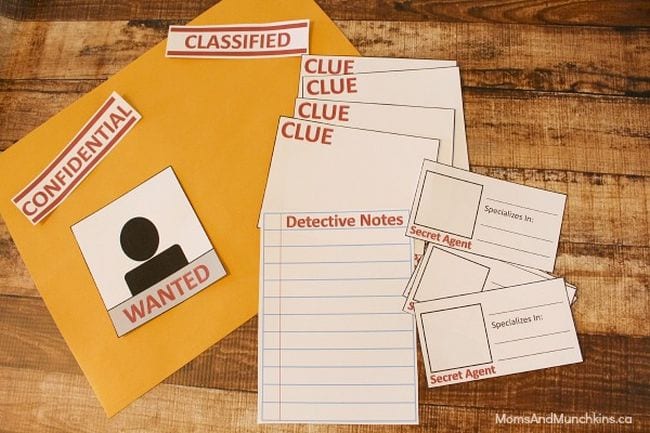
Jan R. expands on the research activity by turning her students into detectives. She puts all the documents in envelopes marked TOP SECRET and stashes them around her room. She even gives them magnifying glasses to read the fine print! Use the free printables from Moms & Munchkins to make this even more fun.
20. Introduce yourself in a movie
It’s a bit more work, but teachers point out that you can use these to introduce yourself again and again. Plus, a movie works in both regular and virtual classrooms. Many teachers already have access to iMovie on their school computers. Learn how to use it here.
21. Introduce yourself on Flip
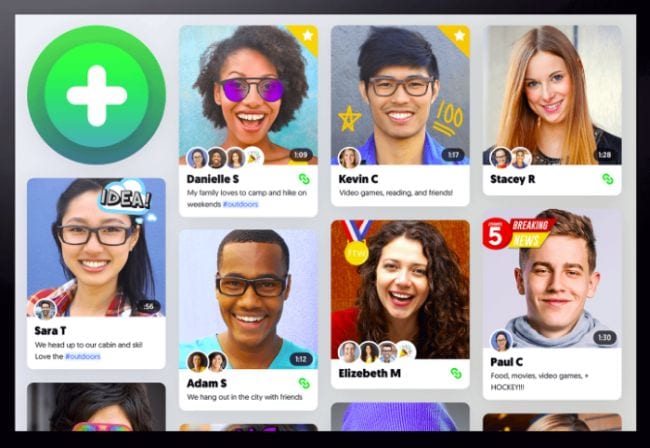
Flip (formerly Flipgrid) is the best interactive tool you’re not using yet. It allows teachers and kids to record and safely post short videos … and it’s completely free! Record a Flip video to introduce yourself to students, then have them do the same. Whether you’re teaching in person or online, this is such a fun way for everyone to get to know each other.
22. Let them do the math
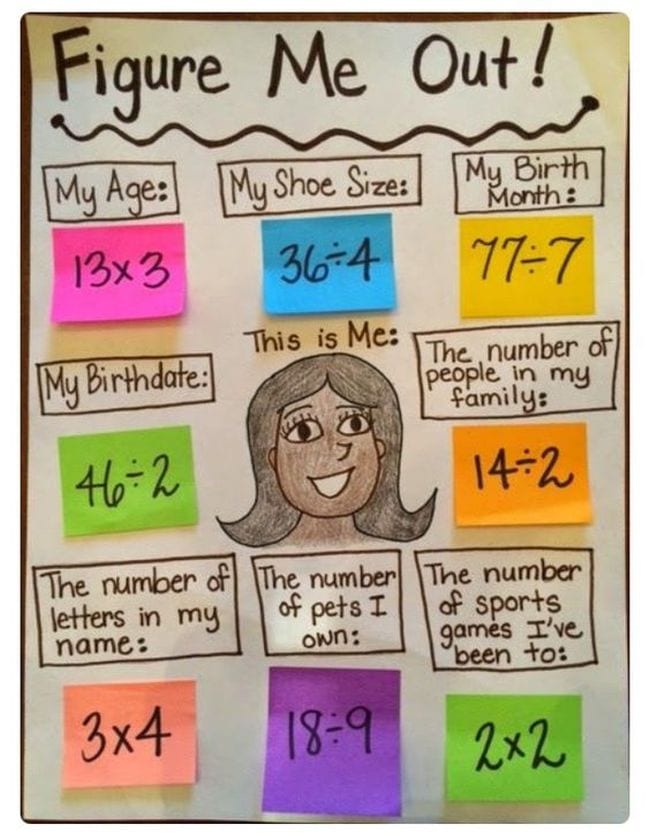
Sneak a little math review into your teacher introduction with this clever idea! Come up with a series of facts about you that can be represented in numbers, then turn those into math problems. This works at a variety of grade levels, and kids always get such a kick out of it! Learn more from The Magnificent Fourth Grade Year .
23. Design a T-shirt
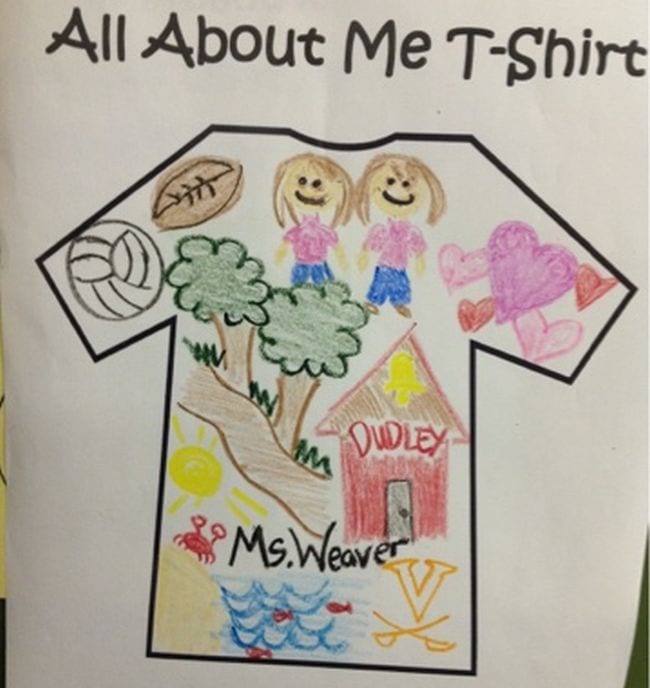
Wear your personality on your sleeve! Draw the outline of a shirt and decorate it with information about yourself. Have your students do the same and then use them to adorn your room, like Counseling Corner does. (Feeling ambitious? Decorate and wear a real T-shirt instead!)
24. Draw a name map
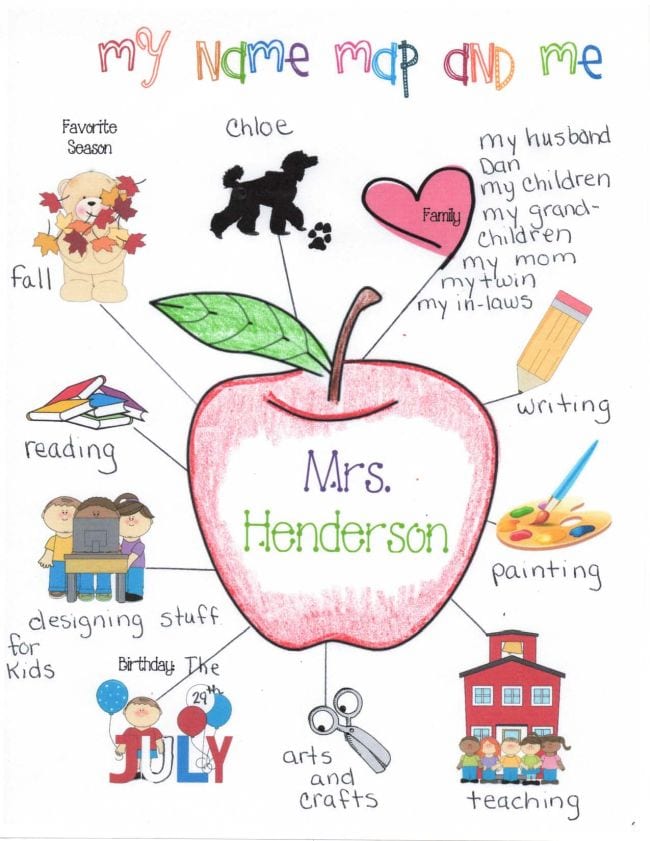
Mapping is an excellent writing strategy, and you can teach the concept early on with a fun name map. Create one to introduce yourself on the first day of class, then have your students do the same. Find out more from TeachWithMe.com .
25. Put together a name tent
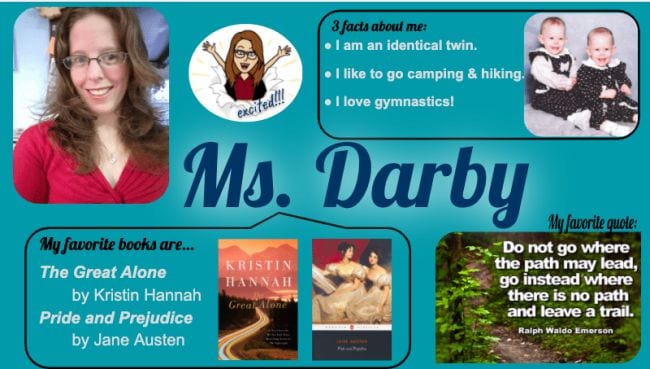
Name tents work in traditional or virtual classrooms. In an in-person classroom, prop this on your desk for the first week or so. Online, post the image during breaks or leave it on the corner of the screen. (Kids can do this activity too!) Learn more from Spark Creativity .
26. Give them the scoop on you
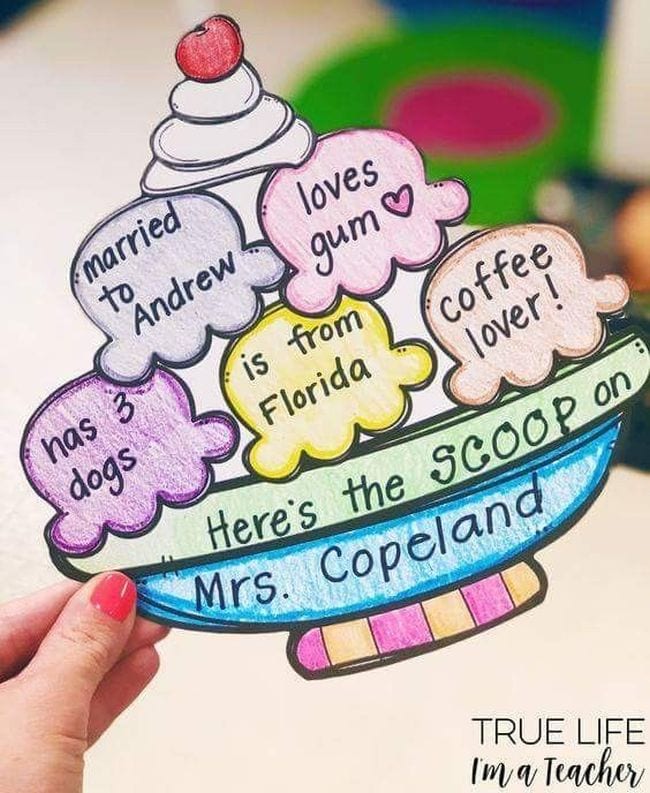
Is there any cuter way to introduce yourself to your students? If you really want to guarantee yourself the “best teacher ever” award, you could have an ice cream sundae party to go along with it! Learn more from True Life I’m a Teacher .
27. Let your star shine
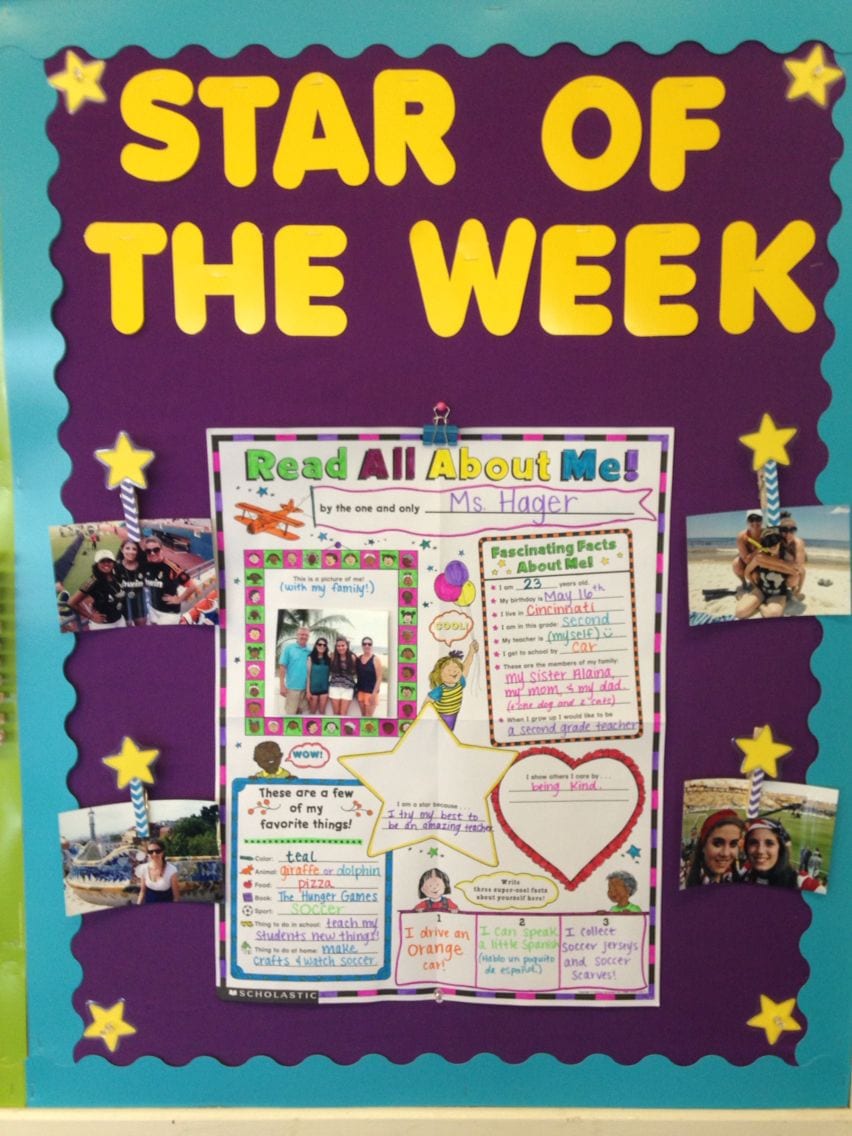
“Every week during the year, one student is Star of the Week and they get to display a collage of their favorite things in the classroom,” says Judith G. “For the first week, I’m the star and my collage allows my students to get to know me.” Use this example from Amanda Hager on Pinterest for inspiration.
28. Dress the part

“I know my students think of me as a bit of a geek (hey, what can I say, I’m a math teacher!) so I totally geek out for the first day of school,” admits Greg S. “I wear a pi T-shirt and thick glasses and really play up the geeky math teacher thing.” Want to go all out? Try these teacher dresses that make you look just like Ms. Frizzle!
29. Play Red Light, Green Light, getting-to-know-you style
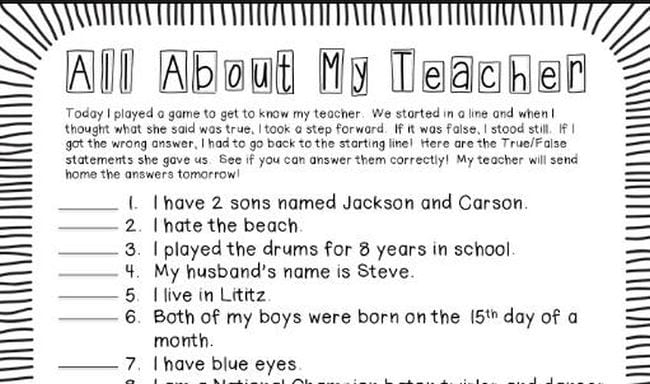
Here’s a fun twist on the classic “Two Truths and a Lie” (another teacher-introduction favorite). Line kids up on one end of the room or playground. Stand on the other side, and make a statement about yourself. If students think the statement is true, they take one step forward. If they’re wrong, they go back to the start! The first student to reach you is the winner. Learn more about this unique way to introduce yourself from Rulin’ the Roost .
30. Write an autobiographical poem
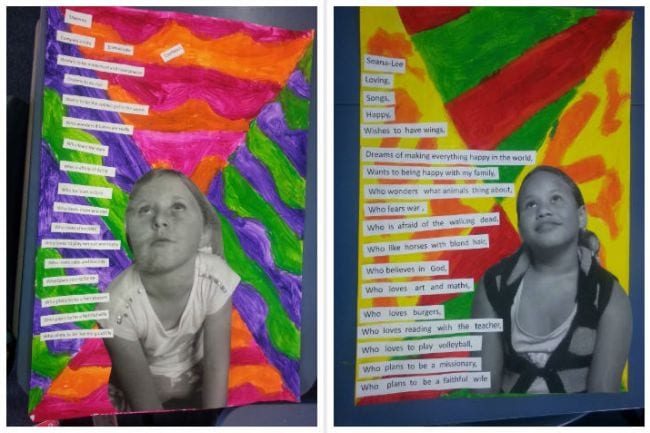
This idea comes from Brianna H., who says, “I like to do an autobiographical poem. I do a model about myself to use as a guide for them. Students write their own using the template and then write it on construction paper and cut out images to create a collage around it.” See this project in action from Melulater.
31. Show them you’re one part of the puzzle
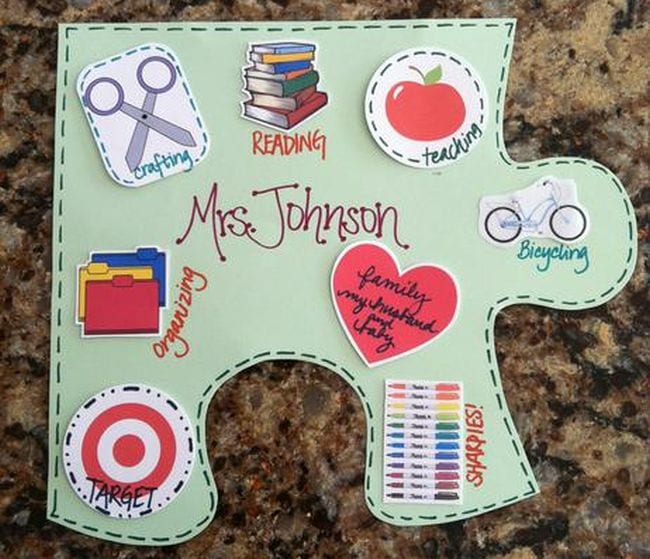
Use this cute idea to introduce yourself and create a terrific back-to-school bulletin board all at once! Personalize your puzzle piece with pictures or facts about yourself. Have kids do the same, and put all the pieces together to make a terrific mural for your classroom. Learn more from Supply Me .
32. Assemble a picture collage
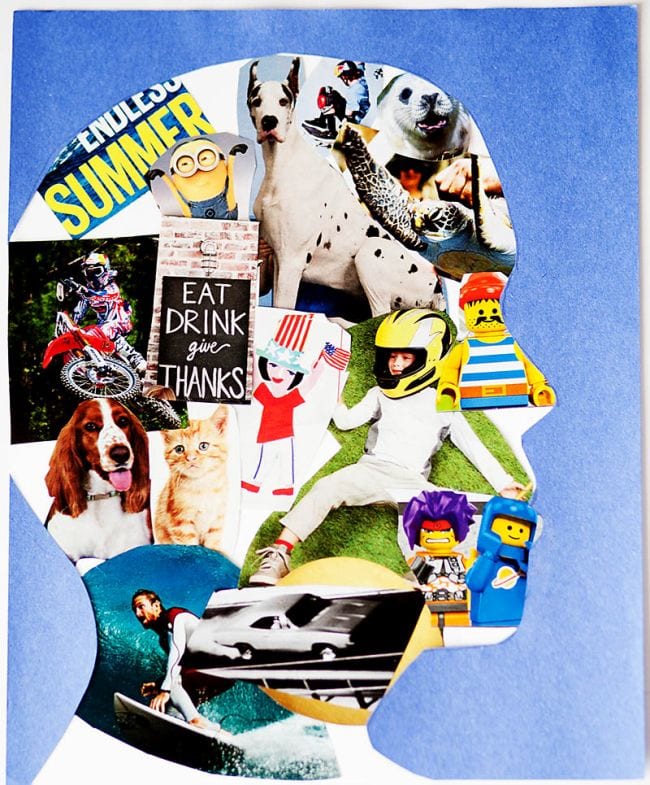
Use pictures to make a collage that tells kids about you with pictures instead of words. “We do a Get to Know Me in Pictures,” says Paige T. “I made one for myself and I introduce myself to the whole class using mine.” If you really want to get creative, make your collage in the shape of your silhouette. Learn how from Kix. (This works online too— try it using Padlet .)
33. Map out a timeline of your life
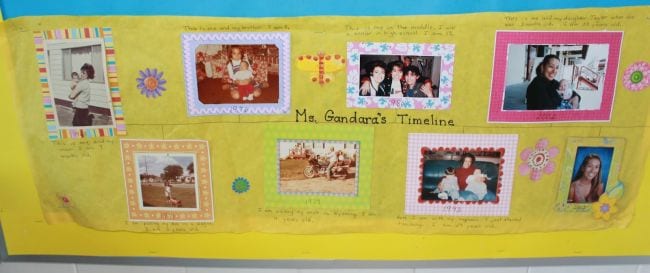
Draw a timeline on the whiteboard before you introduce yourself, suggests Jan R. As you share facts about yourself from different points in your life, have kids come up and add those events to the right place on the timeline. Make it even more fun by adding photos from your life, like this one from Surfin’ Through Second .
34. Craft a get-to-know-you cloudburst
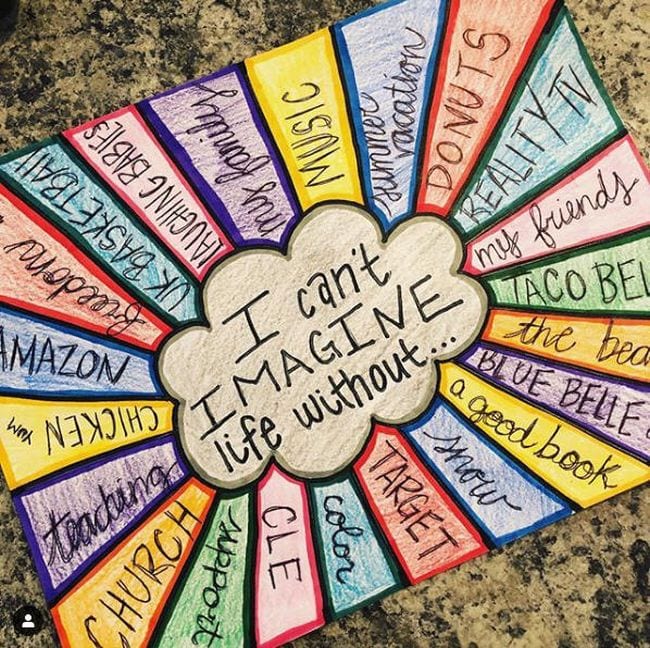
This simple and colorful craft lets students know what’s important to you. Have them make their own so you can get to know them too. Hat tip to GuysTeachToo on Instagram for this idea.
35. Write a Mystery Box essay
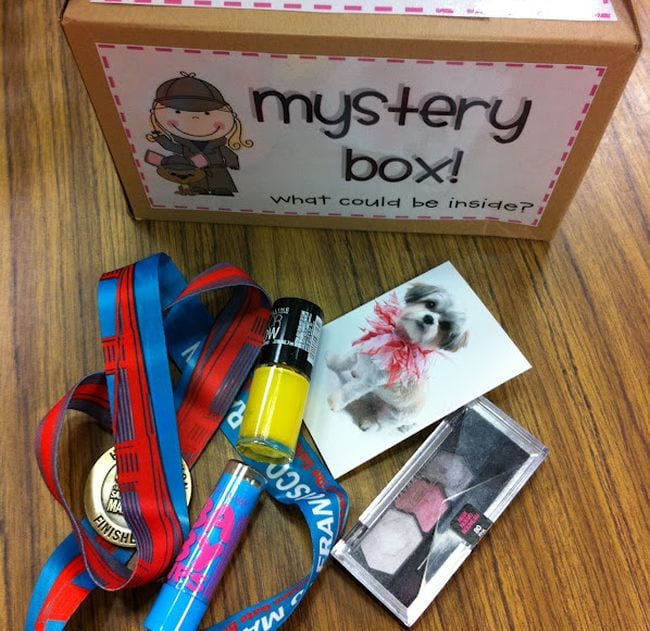
Dawn M. explains, “I put 3 items that represent me in a bag and use it to teach the 5-paragraph essay format. Each item is one paragraph of my essay. Then I share my essay with the kids and pull each item out while reading that item’s paragraph.” She follows up by having kids write their own introductory essays using the same format. See how one teacher uses this activity at Welcome to Room 36 !
36. Pop an emoji bubble
How do you introduce yourself to your students come share your ideas and get advice on the weareteachers helpline group on facebook ., plus, check out icebreakers for middle and high school students that really work .
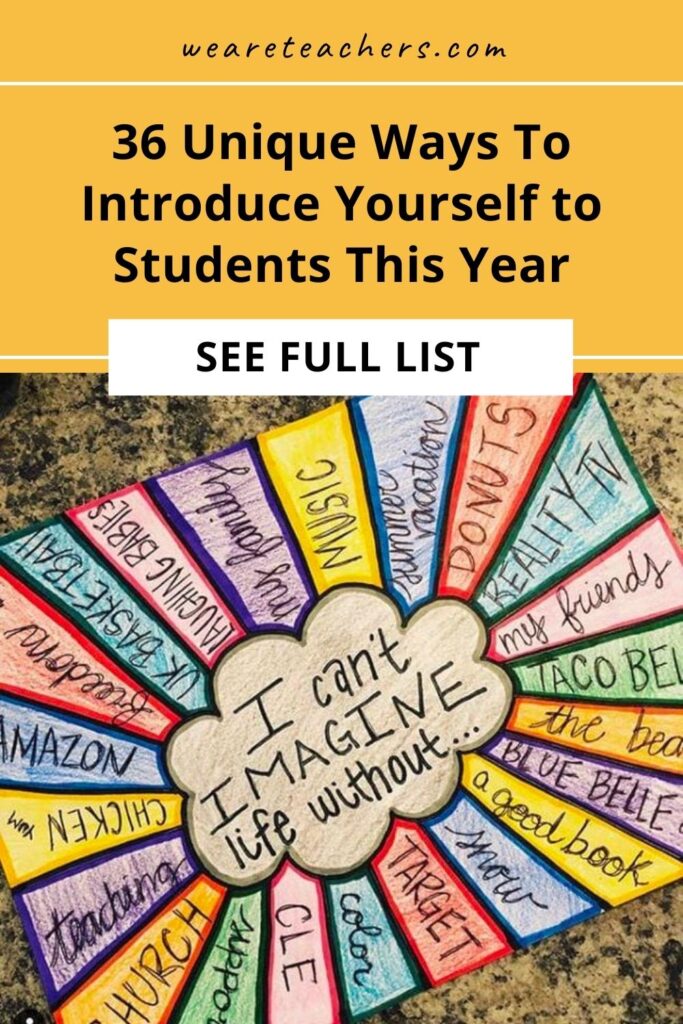
You Might Also Like
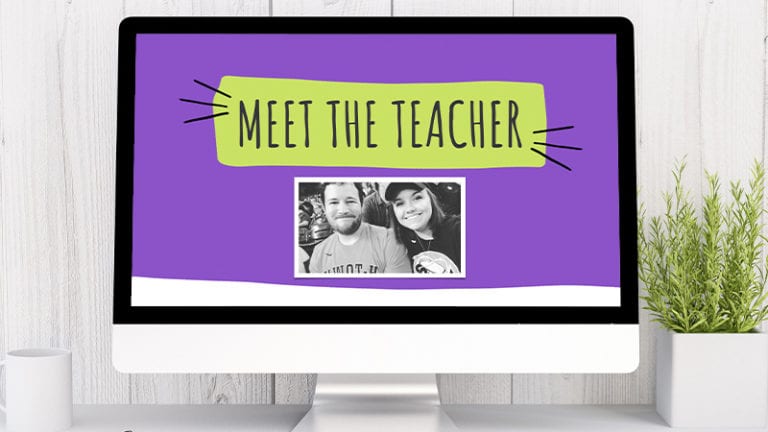
Start the School Year Off Right With This Editable “Meet the Teacher” Slideshow
A colorful way to introduce yourself. Continue Reading
Copyright © 2024. All rights reserved. 5335 Gate Parkway, Jacksonville, FL 32256

IMAGES
VIDEO
COMMENTS
These three paragraphs are called the body of the essay. However, an essay wouldn't be an essay without an introduction at the beginning and a conclusion at the end. All together that's five paragraphs and we could structure it like this: With an introduction, body and conclusion every essay has three main parts.
In a C1 Advanced essay there are basically four things: Introduction. First topic point. Second topic point. Conclusion. From that, we can make four paragraphs and this applies to every single essay you are going to write to practise or in the official exam. Let's have another look at our example from earlier.
Let me show you all the little tips and tricks that will take your essay writing skills to the next level. We discuss how to analyse a task as well as the ty...
What a typical essay task looks like. First of all, let's check out at a typical task and you will see very quickly what you need to look out for when analysing it. Source: Cambridge English Assessment C2 Proficiency Handbook for teachers. In every essay task, you have to read two short texts (about 100 words each) just like the ones above.
In the conclusion we want to achieve a few different things: Summarise what you wrote in your article. Comment on the topic or give your opinion one last time. End your article in an interesting way. The last paragraph shouldn't be too hard to write if you've done a good job with your introduction and topic paragraphs.
Hi guys,My name is Phill and I'm an English teacher from Germany.I try to bring you the best content possible so you can improve your English and get ready f...
There are four marking scales in the writing exam. Each of these scales looks at specific aspects of your writing. Generally speaking the four parts are: Content - answering the task, supporting your ideas. Communicative achievement - register, tone, clear ideas, conventions of the specific task type. Organisation - structure of the text ...
If you want to write the perfect essay for Cambridge B2 First (FCE), this video will show you exactly how to do it. Discover the best structure and learn abo...
Each of these two pieces of writing needs to be between 140-190 words in length, or 280-380 words in total. As there are five different parts to the exam, Writing counts 20% towards your overall grade. In the writing paper there are two parts, the first one being an essay and the second one your choice of several possible types of writing.
Read More Cambridge B2 First (FCE): How to Write an Email/Letter. Page navigation. 1 2 3 Next Page. Welcome to teacherphill.com! Teacher Phill. Hi, my name is Phill. I'm an English teacher with over a decade of experience in four different countries and I want to help YOU pass your Cambridge English exam. Let's go!
If you want to write the perfect B2 First Essay, you need to plan your essay before you start putting the pen to the paper. But BEFORE you plan, you need to ...
Hi, my name is Phill. I'm an English teacher with over a decade of experience in four different countries and I want to help YOU pass your Cambridge English exam. Let's go! Please note that I am part of Amazon's affiliate programme so I receive a small commission from things you buy after you follow one of the links on this website.
TEACHER PHILL. Let's shape your English future together! Do you finally want to pass your Cambridge exam or, if you are a teacher, help your students get over the hump? Let me help you reach your goals! ... Excellent explanation of FCE report writing - one of the best and clearest I have seen. Thank you! Karina.
Introduction. In the PET exam you always have to write an email, but you can choose if you want to write an article or a story. In an article task you get the topic from a website or magazine and there is some information or questions that you have to write about. Also, your language should normally be between neutral and informal.
Check out how to write great reviews in the Cambridge B2 First Writing exam. We look at everything you need from the typical structure to in-depth analyses o...
An essay requires certain things to get high marks! If you do not plan your B2 First FCE Essay you will forget to include what is necessary to obtain the hig...
How to Write an Essay - Teacher Phill - Free download as PDF File (.pdf), Text File (.txt) or read online for free.
This document provides guidance on how to write an essay for the Cambridge B2 First (FCE) exam. It explains that essay writing for the exam follows a predictable structure that can be planned in advance. The essay consists of 3 main parts - an introduction, 3 body paragraphs addressing the topic points, and a conclusion. The introduction should put the topic in context, paraphrase the question ...
1. The document discusses how to write an article for the Cambridge B2 First (FCE) exam. 2. It notes that articles should be interesting and engaging for readers by including the writer's personal opinion. 3. Guidance is provided on article structure, including an introduction, 2-3 topic paragraphs addressing questions or points, and a conclusion. Language use should be semi-formal to informal ...
Part 1 of the writing test - there are 2 parts total. 140-190 word limit. You have about 40 minutes to plan and write your essay. You must answer a question using two notes and your own idea. The topic requires general knowledge only. The essay is always formal because it is written "for your teacher".
Tutor Phil's channel is for adult learners who struggle with writing in English! Subscribe now and learn essay writing, expand your vocabulary, master reading comprehension, and get productivity ...
It's a good idea to prepare to write this essay at least three times. First, there's a rough draft that should be carefully proofread. Students can ask a teacher or other professional to also look at their paper. Then students should repeat this process once or twice more until they're happy with the results.
Personal Epistemology and Teacher Education. Edited by J. Brownlee, G. Schraw and D. Berthelsen: Pp 295. NewYork and London: Routledge. 2011.£ 85.00 (hbk). ISBN 0415883566. [REVIEW] Jon Davison - 2012 - British Journal of Educational Studies 60 (2):194-196.
Read More Cambridge C2 Proficiency (CPE): How to Write an Essay. Page navigation. 1 2 Next Page. Welcome to teacherphill.com! Teacher Phill. Hi, my name is Phill. I'm an English teacher with over a decade of experience in four different countries and I want to help YOU pass your Cambridge English exam. Let's go!
Tips for writing your college essay. Your college essay format and writing should be both compelling in clear. So, as you're writing your college essay, keep these tips in mind: 1. Be authentic. One of the most essential parts of how to format a college application essay is to be authentic.
Many teachers have two versions of their teaching philosophy: a long form (a page or so of text) and a short form. ... Think back to any essay you've ever written and follow a similar format. Write in the present tense; your philosophy isn't aspirational, it's something you already live and follow. ...
teaching ChatGPT best practices in her writing workshop class at the University of Lynchburg in Virginia, said she sees the advantages for teachers using AI tools but takes issue with how it can ...
Dawn M. explains, "I put 3 items that represent me in a bag and use it to teach the 5-paragraph essay format. Each item is one paragraph of my essay. Then I share my essay with the kids and pull each item out while reading that item's paragraph." She follows up by having kids write their own introductory essays using the same format.